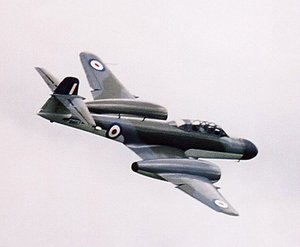Gloster Meteor
|
|
| Gloster Meteor | ||
|---|---|---|
 Gloster Meteor at Waddington, England, 2001 |
The Gloster Meteor was the RAF's first jet fighter aircraft, introduced into service only weeks after the Messerschmitt Me 262 in August 1944. Versions of the Meteor remained in front-line service for many years, and as a night fighter even longer.
| Contents |
History
Development began in November 1940 following the appearance of the turbojet designed by Frank Whittle. Designed by George Carter of the Gloster Aircraft Company, eight prototypes were produced. Originally the aircraft was to have been named Thunderbolt, but confusion with the American Republic P-47 led to a name change to Meteor.
The fifth prototype was the first Meteor to fly, when it made its first test flight on March 5, 1943, piloted by Michael Daunt. The prototypes were powered by two de Havilland Halford H.1 turbojets, but de Havilland reserved the production of these engines for its own de Havilland Vampire design.
For the production Meteor Mk. I the engine was switched to the Whittle W.2 design, by then taken over by Rolls-Royce. The current W.2B/23C turbojet engines produced 7.56 kN of thrust each, giving the plane a maximum speed of 417 mph (670 km/h) at 3,000 m, and had a range of 1,610 km. It was 12.5 m long with a span of 13.1 m, had an empty weight of 3,690 kg, and a maximum take-off weight of 6,260 kg. The construction was all-metal with conventional low straight wings, the turbojets were mid-mounted in the wings, and the tailplane was high-mounted to keep it clear of the jet exhaust. It was armed with four 20 mm Hispano cannons.
Meteor.kemble.750pix.jpg
The first aircraft were delivered to the Royal Air Force on July 12, 1944 and one was also sent to the US in exchange for a Bell YP-59A Airacomet for comparative evaluation. The Meteor Mk. I saw action for the first time on July 27, 1944 against the V1 Flying Bomb. The Meteor never saw aerial combat against the Luftwaffe despite flying missions over Germany from January 1945, using the Mk. III variant from bases in Belgium.
After the World War II
Meteors saw prolonged service during the Korean War with No. 77 Squadron Royal Australian Air Force. The unit had a few early successes in jet versus jet combat, against less-experienced MiG-15 pilots. However, increasing losses to the newer and generally superior Soviet-built fighters saw Meteors relegated to ground attack duties, a role in which they performed well.
Production of the aircraft continued until 1954 and almost 3,900 were made, mainly the Mk. 8. The Meteor was also operated by the airforces of Argentina, Belgium, Brazil, France, Egypt, Israel, New Zealand, Syria and Sweden. Late versions, beginning with the F.8 in 1948 were the first British production aircraft to be equipped with ejection seats.
Although many Gloster Meteors survive in Museums and collections only five remain airworthy, four in the United Kingdom and a F8 fighter which was exported to Australia in 2002.
Specifications (variant described)
General characteristics
- type: Meteor F.MkI
- Crew: 1
- Capacity: 1
- Length: 41 ft (12.5 m)
- Wingspan: 43 ft (13.1 m)
- Height: 13 ft (4.0 m)
- Wing area: 374 ft² (34.7 m²)
- Empty: 8,140 lb (3,690 kg)
- Loaded: lb ( kg)
- Maximum takeoff: 13,800 lb (6,260 kg)
- Powerplant: Engine type(s), 2 × Rolls-Royce W.2B/23C Welland I turbojets, rated at 1700 lbf (7.56 kN) st dry each
(Information source: http://www.xs4all.nl/~fbonne/warbirds/ww2htmls/glosmeteor.html)
Performance
- Maximum speed: 417 mi/h (670 km/h)
- Range: 1000 mi (1610 km)
- Service ceiling: ft ( m)
- Rate of climb: ft/min ( m/min)
- Wing loading: kg/m² ( lb/ft²)
- Thrust/weight:
See also
External links
- http://www.meteorflight.com
- http://www.warbirdalley.com/meteor.htm
- http://www.kotfsc.com/aircraft/meteor.htm
- http://www.iwm.org.uk/duxford/brit9.htm
- http://www.us-israel.org/jsource/History/meteor.html
- http://www.chez.com/jeromeodille/avions/meteor.htm
- http://www.vflintham.demon.co.uk/aircraft/meteor/meteor.htm
|
Lists of Aircraft | Aircraft manufacturers | Aircraft engines | Aircraft engine manufacturers Airports | Airlines | Air forces | Aircraft weapons | Missiles | Timeline of aviation |
